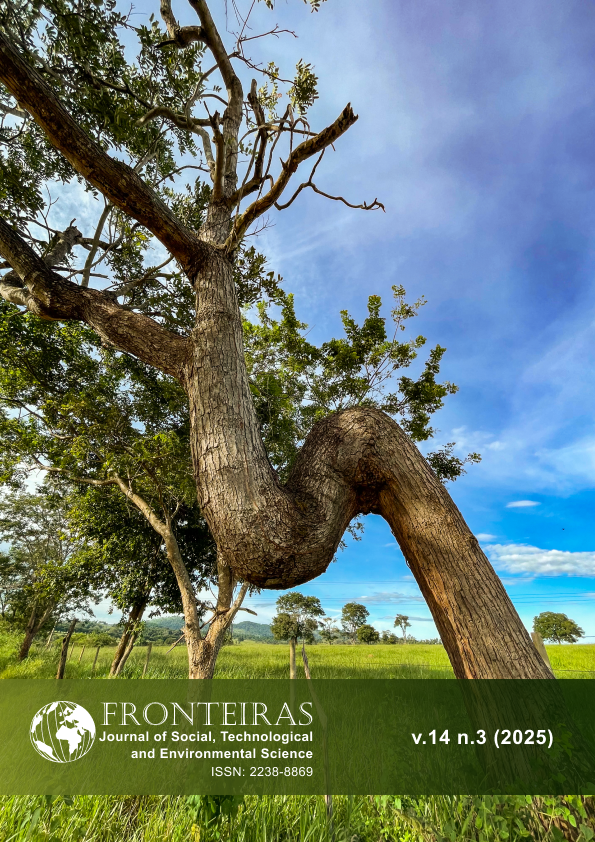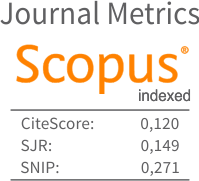Avaliação da Eficiência de Armadilhas para Vespas Sociais (Vespidae - Polistinae): O Papel do Atrativo e sua Relação com os Recursos Alimentares Locais
DOI:
https://doi.org/10.21664/2238-8869.2025v14i3.7998Keywords:
banana, biological control, diversity, guava, honeyAbstract
The management of social wasp colonies is relevant for their use in biological control in agricultural ecosystems. Therefore, this study investigated the influence of different baits in traps used to sample social wasps (Vespidae: Polistinae), considering the available food resources in two agricultural areas at IFMG – Bambuí Campus: a guava orchard and a banana plantation. Sampling was conducted between the months of April and May and October and November 2024, over six consecutive weeks in each area, with weekly replacement of baits. The traps were made from PET bottles and baited with honey, guava juice, and banana juice. A total of 712 individuals belonging to 21 species were collected. Honey proved to be the most effective bait, yielding higher abundance and average species richness in both areas. Guava and banana juices showed similar performances, regardless of the local crop. The results indicate that bait efficiency is not related to crop type and that honey is a more effective alternative for sampling social wasps in agricultural environments.
References
Andena SR, Carpenter JM, Noll FB 2009. A phylogenetic analysis of Synoeca de Saussure, 1852, a neotropical genus of social wasps (Hymenoptera: Vespidae: Epiponini). Entomol Amer 115(1):81–89. https://doi.org/10.1664/07-RA-002R.1.
Bichara-Filho CC, Santos GMM, Resende JJ, Cruz JD, Gobbi N, Machado VLL 2009. Foraging behavior of the swarm-founding wasp, Polybia (Trichothorax) sericea (Hymenoptera, Vespidae): Prey capture and load capacity. Sociobiology 53(1):1–8.
Brock RE, Cini A, Sumner S 2021. Ecosystem services provided by aculeate wasps. Biol Rev 96(4):1645–1675. https://doi.org/10.1111/brv.12719.
Deibert P, König D, Kloock B, Groenefeld M, Berg A 2010. Glycaemic and insulinaemic properties of some German honey varieties. Eur J Clin Nutr 64:762–764. https://doi.org/10.1038/ejcn.2009.103.
Dejean A, Cordoba B, Carpenter JM 1998. Nesting site selection by wasp in the Guianese rain forest. Insectes Soc 45:33–41. https://doi.org/10.1007/s000400050066.
Elisei T, Nunez JV, Ribeiro Júnior C, Fernandes Júnior AJ, Prezoto F 2010. Uso da vespa social Polistes versicolor no controle de desfolhadores de eucalipto. Pesqui Agropecu Bras 45(5):958–964. https://doi.org/10.1590/S0100-204X2010000900004.
Elpino-Campos A, Del-Claro K, Prezoto F 2007. Diversity of social wasps (Hymenoptera: Vespidae) in Cerrado fragments of Uberlândia, Minas Gerais state, Brazil. Neotrop Entomol 36(5):685–692. https://doi.org/10.1590/S1519-566X2007000500008.
Ferreira JVA, Morante-Filho JC, Somavilla A, Storck-Tonon D, Benchimol M 2024. Species Richness and Abundance of Social Wasps (Vespidae: Polistinae) Associated with Shaded Cocoa Agroforests (Theobroma cacao L.) in Southern Bahia State, Brazil. Sociobiology 71(4). http://dx.doi.org/10.13102/sociobiology.v71i4.11180.
Freitas BMV, da Silva JNF 2021. Caracterização físico-química de refresco, néctar e suco tropical comercial sabor goiaba. Braz J Dev 7(10):95051–95058. https://doi.org/10.34117/bjdv7n10-16.
Gotelli NJ, Ellison AM 2004. A primer of ecological statistics. Sinauer Associates, Sunderland, 510 pp.
Hammer Ø, Harper DAT, Ryan PD 2005. Past: paleontological statistics software package for education and data analysis. Palaeontol Electronica 4:1–9.
Hunt JH, O’Donnell S, Chernoff N, Brownie C 2001. Observations on two neotropical swarm-founding wasps Agelaia yepocapa and Agelaia panamaensis (Hymenoptera: Vespidae). Ann Entomol Soc Am 94:555–562. https://doi.org/10.1603/0013-8746(2001)094[0555:OOTNSF]2.0.CO;2.
Jacques GC, Barbosa LD, Vilela DS, Dobizc JM, Silveira LCP, Souza MM 2024. Social wasps (Vespidae: Polistinae) of Minas Gerais, Brazil: richness and distribution. Rev Chil Entomol 50(4). doi:10.35249/rche.50.4.24.12. https://doi.org/10.21203/rs.3.rs-4769985/v1.
Jacques GC, Pikart TG, Santos VS, Vicente LO, Silveira LCP 2018b. Niche overlap and daily activity pattern of social wasps (Vespidae: Polistinae) in kale crops. Sociobiology 65(2):312-319. https://doi.org/10.13102/sociobiology.v65i2.2670
Jacques GC, Pires E, Hermes MG, Faria LDB, Souza MM, Silveira LCP 2018a. Evaluating the efficiency of different sampling methods to survey social wasps (Vespidae: Polistinae) in an anthropized environment. Sociobiology 65(3):515. . https://doi.org/10.13102/sociobiology.v65i3.2849.
Jacques GC, Souza MM, Coelho HJ, Vicente LO, Silveira LCP 2015. Diversity of social wasps (Hymenoptera: Vespidae: Polistinae) in an agricultural environment in Bambuí, Minas Gerais, Brazil. Sociobiology 62(3):439–445. https://doi.org/10.13102/sociobiology.v62i3.738.
Kostić D, Georgijev A, Arsić B 2024. Honey: food and a therapeutic agent. Chemia Naissensis 6(2):100-113. https://doi.org/10.46793/chemn6.2.100k
Lourido GM, Lopes TMV, Somavilla A, Guerra KFG 2019. Social wasps as biological control agents against Diaphania hyalinata (Linnaeus, 1767) (Lepidoptera, Crambidae), a cucumber pest in Amazonas, Brazil. Sociobiology 66(4):610–613. https://doi.org/10.13102/sociobiology.v66i4.3576.
Maciel TT, Barbosa BC, Prezoto F 2016. Armadilhas atrativas como ferramenta de amostragem de vespas sociais (Hymenoptera: Vespidae): uma meta-análise. EntomoBrasilis 9(3):150–157. https://doi.org/10.12741/ebrasilis.v9i3.644.
Manyi-Loh CE, Ndip RN, Clarke AM 2011. Volatile Compounds in Honey: A Review on Their Involvement in Aroma, Botanical Origin Determination and Potential Biomedical Activities. Int J Mol Sci 12(12):9514-9532. https://doi.org/10.3390/ijms12129514.
Melo ADS, Foloni IB, Togni OC, Rocha AA, Tofolo VC, Locher GA, Tavares TMV, Giannotti E 2024. Social organization and division of labor of Mischocyttarus drewseni de Saussure, 1857 (Hymenoptera, Vespidae). Braz J Sci 3(10):45-59. https://doi.org/10.14295/bjs.v3i10.623.
Melo AS, Foloni IB, Togni OC, Rocha AA, Tofolo VC, Locher GA, Tavares TMV, Giannotti E 2024. Social organization and division of labor of Mischocyttarus drewseni de Saussure, 1857 (Hymenoptera, Vespidae). Braz J Sci 3. .
Oliveira NS, Ferreira JVA, da Silva RJ, Somavilla A, Volff CEP, Pereira MJB, da Silva DJ, Butnariu AR, Storck-Tonon D 2022. The importance of legal reserve for predator social wasp diversity in an agroecosystem in the Brazilian Cerrado. Stud Neotrop Fauna Environ:1-10. https://doi.org/10.1080/01650521.2022.2147045.
Ortega AG, et al. 1998. Estudio de los componentes volatiles y perfil sensorial de cuatro cultivares de guayaba (Psidium guajava L.). Alimentaria:31-35.
Palandi AN, de Oliveira Silva L, Fôlha-Ferreira ED, de Sousa Oliveira GC, de Castro Jacques G, Magalhães de Souza M 2025. Richness of social wasps (Hymenoptera: Vespidae: Polistinae) in an olive crop (Olea europaea L.), area associated with a mixed fragment of Atlantic Forest in southern Minas Gerais state, Brazil. Rev Chil Entomol 51(1). http://dx.doi.org/10.35249/rche.51.1.25.09.
Prezoto F, Maciel TT, Detoni M, Mayorquin AZ, Barbosa BC 2019. Pest control potential of social wasps in small farms and urban gardens. Insects 10(7):192. https://doi.org/10.3390/insects10070192.
Raveret-Richter M 2000. Social wasp (Hymenoptera: Vespidae) foraging behavior. Annu Rev Entomol 45:121. https://doi.org/10.1146/annurev.ento.45.1.121.
Raw A 1998. Foraging behaviour of Polistinae wasps (Hymenoptera: Vespidae) in a Brazilian city. Trop Zool 11(2):199-210.
Richards OW 1978. The social wasp of the Americas. London: British Museum of Natural History, 580 pp.
Santos JC, Fernandes GW 2020. Social wasp sampling methods. In: Santos JC, Fernandes GW, eds. Measuring Arthropod Biodiversity: A Handbook of Sampling Methods. [S.l.]: Springer, p. 83-106.
Schoeninger K, Somavilla A, Kohler A 2020. Occurrence of social wasps (Hymenoptera: Vespidae) in farming of organic tobacco (Nicotiana tabacum L.) in south of Brazil. Sociobiology 67(1):106. https://doi.org/10.13102/sociobiology.v67i1.4598.
Silva ES, Franco-Assis GA 2021. Diversidade de vespas sociais (Hymenoptera, Vespidae) em um plantio de eucalipto no município de Barreiras, Bahia. Rev Bras Multidisc 24(2):88-100. https://doi.org/10.25061/2527-2675/rebram/2021.v24i2.1032.
Somavilla A, Carpenter JM 2021. Key to the Genera of Social Wasps (Polistinae) Occurring in Neotropics. In: Prezoto F, Nascimento FS, Barbosa BC, Somavilla A, eds. Neotropical Social Wasps. Cham: Springer, p. 327-336.
Souza AG, Silva HM, Dallo JB, Martins LF, Milani LR, Clemente MA 2015. Biodiversity of Social Wasps (Hymenoptera: Vespidae) at Altitudes Above 1600 Meters in the Parque Estadual da Serra do Papagaio, State of Minas Gerais, Brazil. EntomoBrasilis 8:174-179. https://doi.org/10.12741/ebrasilis.v8i3.519.
Souza IC da C, Carvalho ACB, Silva Neto JMD, Fernandes JPC, Junior JDR, Araújo FMMC, Melo RLF 2020. Physical and chemical characterization of tropical fruits of Northeast Brazil. Res Soc Dev 9(6):e125963562. https://doi.org/10.33448/rsd-v9i6.3562.
Tannure-Nascimento IC, Nascimento FS, Zucchi R 2005. Size and colony cycle in Polistes satan, a Neotropical paper wasp (Hymenoptera Vespidae). Ethology. https://doi.org/10.1080/08927014.2005.9522601.
Taylor BJ, Brus EJ, Jeanne RL 2012. Introduction of a scented carbohydrate resource into the nest increases departure rate in Polybia occidentalis. Insectes Sociaux 59(2):151-157. https://doi.org/10.1007/S00040-011-0200-Z.
Downloads
Published
How to Cite
Issue
Section
License
Copyright (c) 2025 Jeicilene Barros Carvalho, Kássia de Castro Silva, Davi Gomes Lima, Gabriel de Castro Jacques, Marcos Magalhães de Souza

This work is licensed under a Creative Commons Attribution-NonCommercial 4.0 International License.
This journal offers immediate free access to its content, following the principle that providing free scientific knowledge to the public, we provides greater global democratization of knowledge.
As of the publication in the journal the authors have copyright and publication rights of their articles without restrictions.
The Revista Fronteiras: Journal of Social, Technological and Environmental Science follows the legal precepts of the Creative Commons - Attribution-NonCommercial-ShareAlike 4.0 International. 


